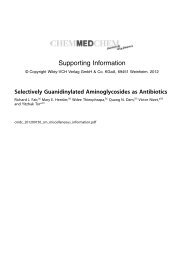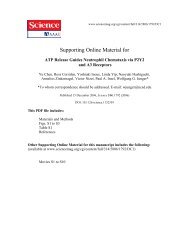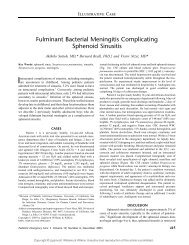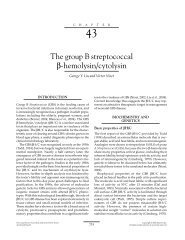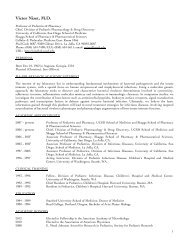BACTERIAL SEPSIS AND MENINGITIS - Nizet Laboratory at UCSD
BACTERIAL SEPSIS AND MENINGITIS - Nizet Laboratory at UCSD
BACTERIAL SEPSIS AND MENINGITIS - Nizet Laboratory at UCSD
You also want an ePaper? Increase the reach of your titles
YUMPU automatically turns print PDFs into web optimized ePapers that Google loves.
cases of clostridial meningitis resulting from C. butyricum<br />
and C. perfringens. Clostridial sepsis has a high mortality<br />
r<strong>at</strong>e [234].<br />
NEONATAL TETANUS<br />
Neon<strong>at</strong>al tetanus is caused by the gram-positive anaerobic<br />
spore-forming bacillus C. tetani. The organism is present<br />
in soil and can be present in human and animal feces.<br />
Infection usually occurs after contamin<strong>at</strong>ion of the umbilical<br />
stump. M<strong>at</strong>ernal and neon<strong>at</strong>al tetanus are important<br />
causes of mortality in developing countries, resulting in<br />
an estim<strong>at</strong>ed 180,000 de<strong>at</strong>hs annually [237]. In the United<br />
St<strong>at</strong>es, tetanus in the newborn is exceedingly rare [238].<br />
Since 1984, only three cases of neon<strong>at</strong>al tetanus have been<br />
reported [238–240]. The most recent case, reported from<br />
Montana in 1998, was an infant born to an unimmunized<br />
mother; the parents used a C. tetani–contamin<strong>at</strong>ed clay<br />
powder to acceler<strong>at</strong>e drying of the umbilical cord. The<br />
use of this product had been promoted on an Internet site<br />
on “cord care” for use by midwives [241].<br />
In many developing countries, the incidence and<br />
mortality of neon<strong>at</strong>al tetanus remain startlingly high<br />
[242–245]. Mustafa and colleagues [246] conducted a retrospective<br />
neon<strong>at</strong>al tetanus survey among rural and displaced<br />
communities in the East Nile Province in the<br />
Sudan and observed an incidence of neon<strong>at</strong>al tetanus of<br />
7.1 cases per 1000 live births, more than double th<strong>at</strong><br />
reported from the stable rural community (3.2 per<br />
1000). In both communities, coverage with two doses of<br />
tetanus toxoid was about 58%. Mortality <strong>at</strong>tributable to<br />
neon<strong>at</strong>al tetanus in Djakarta in 1982 was 6.9 de<strong>at</strong>hs per<br />
1000 live births, and in the island provinces of Indonesia,<br />
it was 10.7 de<strong>at</strong>hs per 1000 live births [247]. Among 62<br />
cases of neon<strong>at</strong>al tetanus in Ethiopia, 90% were born <strong>at</strong><br />
home, and 70% lacked anten<strong>at</strong>al care [245]. Three quarters<br />
of infants in this series died in the hospital, and risk<br />
factors for f<strong>at</strong>al outcome included an incub<strong>at</strong>ion period<br />
of less than 1 week, onset of symptoms less than 48 hours,<br />
tachycardia, and fever [245]. The mortality r<strong>at</strong>e for neon<strong>at</strong>es<br />
with tetanus in Lima, Peru, was 45% and was not<br />
improved with use of intr<strong>at</strong>hecal tetanus antitoxin [248].<br />
A meta-analysis of intr<strong>at</strong>hecal therapy in tetanus suggested<br />
benefit in adults, but not in neon<strong>at</strong>es [249].<br />
Applic<strong>at</strong>ion of contamin<strong>at</strong>ed m<strong>at</strong>erials to the umbilical<br />
cord is associ<strong>at</strong>ed with deep-rooted customs and rituals<br />
in developing countries. A case-control study to identify<br />
risk factors for neon<strong>at</strong>al tetanus in rural Pakistan identified<br />
applic<strong>at</strong>ion of ghee (i.e., clarified butter from the<br />
milk of w<strong>at</strong>er buffaloes or cows) to the umbilical wound<br />
as the most important risk factor [250]. Although commercial<br />
ghee is available in Pakistan, the ghee used in<br />
rural areas is made <strong>at</strong> home from unpasteurized milk.<br />
Oudesluys-Murphy [251] observed th<strong>at</strong> applic<strong>at</strong>ion of<br />
some m<strong>at</strong>erials, including ghee and a stone wrapped in<br />
wet cloth, increased the risk of neon<strong>at</strong>al tetanus among<br />
Yoruba women, but th<strong>at</strong> other practices of cord care<br />
decreased the incidence, including searing of the cord<br />
with he<strong>at</strong> in China during the Ming dynasty and use of<br />
a candle flame to scar the cord in Gu<strong>at</strong>emala. Neon<strong>at</strong>al<br />
tetanus is a preventable disease; use of hygienic techniques<br />
<strong>at</strong> delivery and a program of tetanus toxoid<br />
CHAPTER 6 Bacterial Sepsis and Meningitis<br />
237<br />
immuniz<strong>at</strong>ion of children and young adults, particularly<br />
of pregnant women, are effective in elimin<strong>at</strong>ing this lethal<br />
disease [251–254].<br />
MIXED INFECTIONS<br />
Multiple organisms frequently are present in brain, liver,<br />
or lung abscesses; aspir<strong>at</strong>es in the lung after pneumonia;<br />
or pleural empyema. Such mixed infections infrequently<br />
are found in cultures of the blood or CSF, however.<br />
When several species are found, the significance of each<br />
is uncertain because it is possible th<strong>at</strong> one or more of<br />
the organisms in a mixed culture is a contaminant.<br />
Bacteremia with more than one organism occurs in<br />
p<strong>at</strong>ients with immunodeficiency, major congenital<br />
abnormalities, or contamin<strong>at</strong>ion of a body fluid with multiple<br />
organisms, as is present in peritonitis typically as a<br />
sequela of severe necrotizing enterocolitis in a very low<br />
birth weight infant. Neon<strong>at</strong>al meningitis caused by<br />
S. pneumoniae and Acinetobacter calcoaceticus [255] and sepsis<br />
caused by P. aeruginosa and Yersinia enterocolitica [256] have<br />
been reported. Although included in a series of cases of<br />
neon<strong>at</strong>al sepsis by some investig<strong>at</strong>ors, mixed cultures are<br />
not identified by most. Mixed infections were reported by<br />
Tessin and coworkers [257] in 5% of 231 Swedish<br />
neon<strong>at</strong>es, by Vesikari and associ<strong>at</strong>es [258] in 4% of 377<br />
Finnish infants, and by Bruun and Paerregaard [259] in<br />
7% of 81 Danish neon<strong>at</strong>es. Faix and Kovarik [260] reviewed<br />
the records of 385 specimens of blood or CSF submitted to<br />
the microbiology labor<strong>at</strong>ories <strong>at</strong> the University of Michigan<br />
Medical Center for the period of September 1971 to June<br />
1986. More than one organism was present in 38 specimens<br />
from 385 infants in the NICU; 15 (3.9%) infants had multiple<br />
p<strong>at</strong>hogens associ<strong>at</strong>ed with clinical signs of sepsis or<br />
meningitis. The mortality r<strong>at</strong>e was high (60%).<br />
Factors predisposing to mixed infection included prolonged<br />
rupture of membranes (>24 hours); total parenteral<br />
nutrition; necrotizing enterocolitis; presence of an<br />
intravascular c<strong>at</strong>heter or ventriculostomy; and entities<br />
associ<strong>at</strong>ed with multiple p<strong>at</strong>hogens, including peritonitis,<br />
pseudomembranous colitis, and hep<strong>at</strong>ic necrosis. Chow<br />
and colleagues [217] reported polymicrobial bacteremia<br />
in eight newborns with anaerobic coisol<strong>at</strong>es or aerobic<br />
and anaerobic organisms in combin<strong>at</strong>ion. Jarvis and<br />
associ<strong>at</strong>es [261] reported an outbreak of polymicrobial<br />
bacteremia caused by K. pneumoniae and E. cloacae associ<strong>at</strong>ed<br />
with use of a contamin<strong>at</strong>ed lipid emulsion.<br />
Mixed infections also can include bacteria and viruses<br />
or bacteria and fungi, typically Candida, in the situ<strong>at</strong>ion<br />
of intravascular central c<strong>at</strong>heter or peritoneal infections<br />
associ<strong>at</strong>ed with bowel perfor<strong>at</strong>ion. Sferra and Pacini<br />
[262] reported mixed viral-bacterial meningitis in five<br />
p<strong>at</strong>ients, including neon<strong>at</strong>es with CSF isol<strong>at</strong>es of enterovirus<br />
and GBS in a 10-day-old infant and enterovirus<br />
and Salmonella in a 12-day-old infant.<br />
UNCOMMON <strong>BACTERIAL</strong> PATHOGENS<br />
Numerous additional bacterial p<strong>at</strong>hogens have been<br />
identified as rare or uncommon causes of neon<strong>at</strong>al sepsis<br />
and meningitis. These are listed in Table 6–8 with their<br />
references and were reviewed by Giacoia [263].



